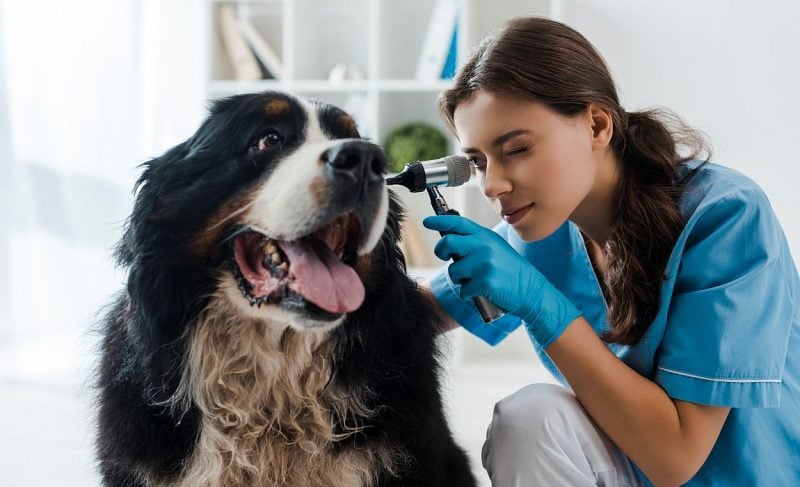In August of 2023, vets in Oregon began treating a handful of dogs suffering from respiratory illness.
There’s nothing unusual about that; dogs get respiratory infections all the time.
But these dogs weren’t getting better or responding to conventional treatments.
One even died after developing pneumonia.
This caused some to worry that we were seeing the work of a new (i.e., novel) pathogen – a phrase no one who remembers 2020 wants to hear again.
Pretty scary-sounding stuff, right?
Then why are some vets and pathologists trying to slow down this viral story? Why do some think there’s nothing new about this illness at all?
We’ll explain.
What Is the New “Mystery” Dog Illness?

Frustration alert: No one knows what this new dog “mystery” illness is.
It isn’t even clear that there is a distinct – let alone new – pathogen causing these dogs to fall ill.
Confusing, we know.
So, to better understand the issue, we’ll need to back up and talk about kennel cough.
Kennel Cough: An “Old” Canine Disease

Technically called canine infectious respiratory disease complex (CIRDC) or infectious tracheobronchitis, “kennel cough” is a common canine ailment that frequently afflicts dogs in close-quarters situations, such as boarding facilities.
While kennel cough can sometimes be serious, it’s usually not a huge deal for otherwise-healthy dogs. It’s basically the canine version of the common cold.
Typical symptoms include a runny nose, sneezing, lethargy, reduced appetite, and fever. But the classic sign of kennel cough is a frequent “honking” cough.
It is important to note that kennel cough is not a single disease, nor is it caused by a single pathogen; it’s a syndrome.
As explained by David Needle, Senior Veterinary Pathologist at University of New Hampshire, in an interview with National Geographic:
“A syndrome is just a group of diseases that have similar clinical signs.”
Think irritable bowel syndrome or chronic fatigue syndrome in humans.
What Causes Kennel Cough in Dogs?

Kennel cough can be caused by an array of pathogens.
A bacterium by the name of Bordetella bronchiseptica is the most common culprit, but bacteria in the genus Mycoplasma, as well as Streptococcus equis subspecies zooepidemicus, can also trigger the illness.
But it’s not always bacteria that triggers kennel cough; viruses can also cause dogs to suffer.
A few of the most common viruses that can cause kennel cough include:
- Canine parainfluenza virus
- Canine adenovirus type 2
- Canine influenza virus (subtypes H3N2 and H3N8)
- Canine respiratory coronavirus
- Canine herpesvirus-1
- Canine distemper virus
And in some cases, dogs can wind up with a two-faced attack. As explained by Calder Vets:
“Sometimes the virus is the initial cause, then the bacteria invade the airways and take advantage of the already damaged respiratory tract. In other cases, bacteria infect first, then the virus come [sic] along and do even more damage.”
Vaccinations can help protect dogs from Bordetella and several of the mentioned viruses, but kennel cough remains a common ailment. According to Control Point Diagnostics, a veterinary diagnostics company, U.S. veterinarians treat approximately 5.5 million kennel cough cases annually.
Given that there are in the neighborhood of 85 million dogs in the U.S., that means roughly 1 in 15 dogs will suffer from the ailment in a given year.
According to some estimates, 80% of these cases fall into the “mild” category. Of the remaining severe cases, 5% to 10% ultimately prove fatal.
How These New Cases Differ from Traditional Kennel Cough

Like humans who come down with the common cold, most dogs fight off kennel cough on their own.
Accordingly, vets often approach kennel cough like human doctors treat the common cold. They’ll prescribe antibiotics in some cases (especially if the kennel cough causes bacterial pneumonia), but they tend to focus on supportive treatment – fluids, rest, anti-inflammatories, and the like.
This is where this “new” illness appears to differ from run-of-the-mill kennel cough, and it illustrates how it was initially “detected”: A few dogs presenting with what appeared to be kennel cough were getting very sick.
Over time, even more dogs started exhibiting the same pattern.
Some of the dogs began developing pneumonia very quickly, and in some cases, the pneumonia didn’t seem to respond to antibiotics. Several of these dogs ultimately died.
In the weeks following August of 2023, more and more veterinarians began reporting similar, “atypical” cases of kennel cough.
According to the American Veterinary Medical Association (AVMA), the “new” disease appears to cause the following symptoms (paraphrased):
- Mild to moderate bronchitis that lasts for up to two months and doesn’t respond well (or at all) to antibiotics
- Chronic pneumonia that doesn’t respond to antibiotics
- Acute pneumonia that may become severe in a day or two
- Difficulty breathing
- Wheezing
- Dehydration
- Fever
- Eye or nose discharge
- Weight loss
- Lethargy
Where Are We Now? How Widespread Is the New Dog Illness?
There isn’t a great nationwide reporting system for these types of atypical kennel cough cases, but there have been at least 16 such reports in the state of Washington and 200 in Oregon by the beginning of December 2023.
Though the cases in Oregon initially sparked much of the attention, atypical kennel cough cases have now been reported from across the country. Cases have been reported in 16 states, from Washington and California to New Hampshire and Florida.
However, the associated media attention (including that of the traditional and social flavor) the disease is garnering may be complicating things.
Most pet owners are concerned; some are freaking the hell out.
Vets are being inundated with calls, and owners are pulling their dogs out of daycares and opting for alternatives to boarding facilities.
But while this fear seems understandable, it may be disproportionate to the threat.
At least, that’s the argument a handful of veterinarians and pathologists are putting forth.
What Are Vets Advising Owners to Do About the New Dog Respiratory Illness?

Before we explain how some scientists and vets are pushing back on the hysteria surrounding this “new” illness, it’s important to point out that almost every vet within earshot of a reporter, microphone, or social media channel is sharing the same basic advice.
Essentially, they’re recommending owners:
- Ensure that their dogs are fully vaccinated for all canine respiratory diseases
- Avoid big canine crowds when possible
- Keep healthy dogs away from sick dogs
- Wash their hands after interacting with dogs
- Contact their veterinarians when confronted with a dog showing signs of illness
Hardly mind-blowing stuff.
On the Hunt: Some Scientists Search for the New Pathogen

Any time a new disease is noticed, or an old disease starts acting in new ways, it makes sense to investigate. And that’s precisely what pathologists and other canine health authorities have begun doing.
In fact, some had already been working the case by the time reports started trickling out of Oregon.
While the current outbreak (for lack of a better term) seemed to start in August of 2023, a few vets in New Hampshire began reporting an unusual respiratory illness in dogs during the summer of 2022.
That is how the aforementioned veterinary pathologist, David Needle, became involved with these atypical kennel cough cases. He started traveling around New England, collecting samples from sick dogs.
As one would expect, Needle and his team started by testing for common kennel cough culprits, but that didn’t pan out. As he explained in the same National Geographic interview:
“We found no known RNA or DNA viruses. No fungus, bacteria, protozoa, metazoa. Nothing closely related to a known pathogen.”
But Needle wasn’t the only researcher investigating these sick dogs.
Graduate student Lawrence Gordon at the University of New Hampshire’s Hubbard Center for Genome Studies began analyzing samples, too. And he turned up something interesting: About two-thirds of the samples contained small bits of DNA that appeared to belong to a previously unidentified bacteria species.
And, as it turns out, it’s a pretty strange one, according to Needle, who discussed it with NBC Chicago:
“It’s smaller than a normal bacterium in its size and in the size of its genome. Long story short, it’s a weird bacterium that can be tough to find and sequence.”
Fast forward to 2023, and the team has expanded their analysis to include dogs from Massachusetts and Rhode Island.
Guess what they found in some of the cases from Rhode Island?
That’s right – the same bizarre bacterium.
As of December 2023, the team is working on samples from other states, including Oregon. Time will tell if these dogs are harboring the same bacteria.
But as it turns out, it may not even matter.
Scientists and Vets Push Back: The “New” Dog Disease May Not Be New at All

Discovering that a bacterium – even a strange one – is the cause of this new respiratory illness would ostensibly be a good thing. After all, we should be able to figure out some antibiotics that work against it, though that may take some time.
However, the problem is that this newly identified bacteria may not be the cause of the illness. Remember that scientists were not able to collect it from all sick dogs.
That could simply be because – as Needle puts it:
“…it is so small, the bacterium is particularly hard to find and sequence.”
But even if they found the sample in all sick dogs, it still doesn’t mean this bacterium was causing the illness.
As explained by Dr. Jason Stull, an assistant professor of veterinary preventive medicine at Ohio State University, in a USA TODAY interview:
“…even though a bacteria or virus is found in a sick dog, it doesn’t mean the pathogen is what’s causing the disease.”
Needle says this himself:
“A finding like this is potentially pretty exciting, even though we still have to see how it develops to a place where we are comfortable saying this is a pathogen in the syndrome.”
His team even allows for the possibility that this bacterium may be:
“…part of the dog microbiome and has recently developed the capacity to cause disease.”
That seems to track with Needle’s comments in a Scientific American interview, stating that the bacterium appears to be:
“…missing key genes that would allow it to survive on its own in the environment.”
But other authorities push back even harder.
For example, according to Dr. Scott Weese with the Ontario Veterinary College, while speaking with Curbed:
“So far, all they could say is that they found it in some sick dogs — but are we seeing it in healthy dogs, too?”
Comments made by Weese elsewhere – including a Trupanion-hosted Q&A on November 30th of 2023 – suggest that he’s skeptical we’re seeing a new disease.
As his statements were reported by AVMA.org:
“The big question at the moment… is whether the recent CIRDC cases are a result of changes in how dogs have been cared for and managed or something else.”
It appears as though Weese thinks the former explanation makes more sense, particularly in light of the changes another disease – COVID-19 – prompted among dog owners.
“What the net result could be is we’ve got more dogs that have a lower level of resistance because they’ve been exposed to other dogs less over the last couple of years, and they’ve had less vaccinations. That means, just with our normal respiratory diseases that are always circulating, we’ll see more spikes in disease cases.”
Weese goes on to say that:
“…most times the strange cases we see are just the usual suspects behaving a little bit differently.”
And he lays it out even more on his blog:
“…it’s more likely that it’s a longstanding cause of disease that we’ve never diagnosed before, versus a new bug that’s recently emerged and is starting to spread. The current disease patterns don’t really fit with emergence of a new highly transmissible pathogen.”
But Weese isn’t the only one expressing doubt about this newly discovered bacterium being the cause of these new cases.
After all, the Oregon Veterinary Medical Association contends that a:
“…viral infection does appear to be the most likely cause,”
while accepting the fact that no viral agent has been identified.
Others, such as Cornell College of Veterinary Medicine virologist Colin Parrish, doubt that the new “disease” is a single entity.
As he explained to Curbed:
“…it’s more likely that there are a few different things going on.”
He continues:
“Some of them may be connected, but others are probably due to other diseases. With the viral story spreading, though, everyone’s lumping any coughing dog into the same category of mystery disease.”
Weese echoes this last sentiment pretty clearly when talking about how the new disease is being tracked and reported:
“… you might ask them, ‘Do you see respiratory disease in dogs normally?’ ‘Yeah.’ ‘Do you see kennel cough?’ ‘Oh yeah, we see it all the time.’ ‘Why is this different?’ ‘I don’t know, because someone’s calling it something different.’ That’s essentially where we are right now.”
He sums up his thoughts by explaining that:
“But I think social media has really amplified the concern. When you have more cases total, you’re going to have more severe cases. But the numbers don’t indicate a new virus that’s moving through the population and killing lots of dogs.”
The Takeaway: What’s Really Going on with the Mystery Canine Respiratory Illness?

Aside from the fact that some dogs are developing respiratory infections (which happens all the time), some of them are failing to improve when treated (which happens all the time), and a small number of them are dying (which happens all the time) we simply don’t know.
Yet.
But experts in the world of dog medicine and science are working hard on the case.
We’ll have some answers in the coming weeks, months, and years.
There’s not much we typical dog owners can do in the meantime except to employ some basic, common-sense measures to keep our dogs safe.
But most importantly, we need to avoid panicking. We also need to treat every breathless headline with a big ‘ol grain of salt.
It may turn out that this new disease isn’t new at all.
New Dog Respiratory Illness: FAQ

We certainly don’t have all the answers regarding this new canine illness phenomenon, but we’ll try to answer some of the most common questions owners have about it below.
When was the new dog respiratory illness discovered?
It’s not clear that the “new dog respiratory illness” is a single thing, and dogs suffer from respiratory illnesses all the time. That said, some unusual cases were first reported in the summer of 2022 in New Hampshire, and others started being described in Oregon in the late summer or early fall of 2023.
How does the new dog respiratory illness spread?
We don’t yet have many concrete answers, but most vets explain that kennel cough (and similar conditions) are spread via airborne droplets released by coughing or sneezing dogs. It is essentially spread in a manner similar to how human respiratory illnesses are spread.
It may also be spread through contact with contaminated surfaces.
Is there a treatment for the new dog respiratory disease?
There doesn’t appear to be an infallible cure for the new disease – such that one actually exists.
However, most dogs recover from respiratory illnesses on their own, and vets have some treatments for several pathogens that cause kennel cough.
Antibiotics can be used to battle some of the bacteria linked to these diseases, and supportive measures are sufficient in some cases. Further, vaccinations are available for many of the pathogens that commonly cause kennel cough.
Is the new dog respiratory disease fatal?
Unfortunately, some dogs have died from respiratory illness over the last two years. It isn’t yet clear whether that is due to a new pathogen or ones that have already been identified.
What are the symptoms of the dog virus in 2023?
It’s important to note that the dog disease making headlines in 2023 may or may not be a virus. Some researchers suspect that a small, somewhat unusual bacterium is causing dogs to fall ill. Others suspect it is due to pathogens that have long-infected dogs, though they may be acting in new ways.
That said, the disease is causing dogs to suffer fairly typical respiratory symptoms, including cough, fever, nasal discharge, lethargy, and loss of appetite.
There’s still a ton we don’t know about the new dog respiratory illness afflicting pups across the country. But while caution and concern are warranted, there doesn’t seem to be any cause for panic.
Just remember to do the basic, sensible things vets advise to keep your pooch safe and avoid subjecting your pet to unnecessary risks.
Have you changed your pet-care routine since this disease has hit the front page of media outlets? Has your dog suffered from this illness? We’d love to hear your thoughts and experiences in the comments below!














Leave a Comment